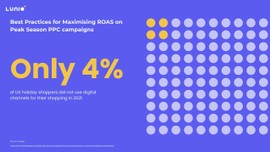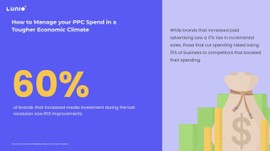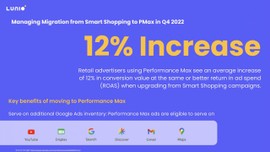The retail holiday season is fast approaching. And with the cost of living rising for everyone, some consumers are already showing signs of more cautious spending. So what steps can you take right now to maximise return on ad spend, avoid abandoned carts, and close Q4 on a high note?
In our latest webinar, we spoke to Nicole Santana, Paid Media Supervisor at Marketwake about how to optimise holiday PPC advertising campaigns during an unprecedentedly competitive year. The conversation was hosted by Lunio’s Content Manager, James Deeney.
Nicole has over 6 years experience in Paid Media and manages several million in yearly ad spend for clients across a range of industries. With experience in running campaigns both at in-house and out-of-house paid media departments, Nicole offered a holistic perspective on how to create a successful holiday PPC ad strategy.
Watch the webinar or read the summary below to learn how to maximise your conversion and minimise abandoned carts over the holiday season.
Webinar Timestamps
- 00:00 – Intro & agenda
- 04:23 – How to adjust your holiday PPC advertising for 2022
- 07:06 – Offering mystery boxes and tapping into other holiday trends
- 08:50 – Best practices for maximising conversions on holiday PPC ads
- 10:15 – Retargeting strategies to minimise abandoned carts
- 14:10 – Gathering data & insights to prep for holiday season 2023
- 16:46 – Conducting a holiday season PPC post mortem
- 19:20 – Managing PPC spend in a tougher economic climate
- 22:23 – Migrating from Smart Shopping to PMax in Q4
- 28:30 – Outro and access to free resource hub
TL:DR
- Businesses and marketing agencies are starting their holiday PPC prep earlier than ever before. Concerns around supply chain issues and items being out of stock this year means many consumers are already starting to shop for high-demand products.
- Consumer interest in “mystery” items and boxes is spiking. You can further incentivize conversions on high-value products by pairing them with free mystery items. It also allows you to shift surplus stock you don’t want to sell at normal full price.
- Review Google’s holiday shopping trends for 2022 and factor the insights into your prep phase to capitalise on the increased demand.
- Look at audience insights from previous holiday season PPC ad campaigns and use them to your advantage. Set up specific audiences to target ahead of time so you can instantly activate them when needed later down the line.
- Don’t limit your retargeting ads to abandoned cart items only. Pair abandoned items with related higher-value products and offer a generous discount when consumers purchase both as a combo deal.
- To avoid a spike in abandoned carts in the days leading up to holiday events, offer free next-day shipping on all orders over a given value.
- Costs per click shoot up dramatically during the holidays due to increased competition, increasing risk exposure to click fraud. If you’re paying more than $5 – 10 per click you should protect your budget by eliminating all invalid activity from your PPC campaigns.
- If direct competitors scale back PPC budgets in the face of economic uncertainty, it creates an opportunity to increase your visibility on the most competitive terms in your industry. Slashing ad spend undermines growth and shareholder value in the long run.
- Manually migrate your Smart Shopping campaigns over to Performance Max and configure your setup the right way before Google does it automatically at the end of Q3.
- Make a decision on whether or not to use the “final URL expansion” feature with Performance Max. If you switch it on, review Google Analytics to make sure your page paths are still ok and you aren’t spending on non-converting traffic.
- Create separate asset groups in Performance Max for seasonal items and best sellers to give yourself a greater degree of control over budget spent on these.
- Third-party cookies are set to be discontinued in 2024. Do everything you can this holiday season to gather first party data and other audience insights so you can improve your targeting and holiday PPC performance in 2023 and beyond.
- If you haven’t already, make sure you set up Google Analytics 4. If you don’t set it up now, you won’t have access to historical conversion data when you need it next year.
- Once holiday season is over, get all relevant teams in the same room for an extensive post mortem to hone in on what worked and what didn’t. Create a holiday season highlight reel slide deck so you can quickly recap key insights when prepping for 2023.
How to Adjust Your Holiday PPC Advertising for 2022
As the cliché goes, failing to prepare is preparing to fail.
Even though it may still feel far away, now is the time to put a plan in place for key events like Black Friday, Cyber Monday, and Christmas. Nicole said a time-shift in her prep phase was the most notable difference when comparing 2021 to 2022.
“The prep process itself has remained largely the same. But I’d say the biggest change I’ve noticed is in the timeline. In the past, we’d always wait until we got a little closer to the holiday season before we started to get our prep into full swing. Whereas this year, with concerns around items being out of stock due to post-pandemic supply chain issues, we’re seeing consumers starting to shop earlier than ever before”
Despite the ongoing supply chain issues and other macroeconomic factors driving up cost of living, Nicole was quick to point out that consumer spending hasn’t slowed down at all.
“We’re already seeing projections of increased spend, especially on the search side, going into the holiday season. So it’s important to have your promotional calendar laid out well ahead of time for any specific paid campaigns you want to run. You should also look to build in as much automation as you can into your plan to help ease some of the pressure later down the line”
It’s also worth reviewing emerging holiday shopping trends to help set your business up for success, even if that means spinning up a new product offering. One example of this is the increased consumer interest in “mystery” boxes & items. Nicole outlined how they can help boost conversions when paired alongside other higher-value products.
“Google expects the demand for mystery boxes to skyrocket in 2022. And we’ve found them to be very successful for our eCommerce brands. It’s a great way to get rid of surplus or slightly less-than-perfect items you don’t want to sell at normal full price. If you give away a free mystery item alongside a product you really want to push this year, you can drive up conversions by tapping into the psychologically-motivating intrigue of the unknown”
In addition to mystery items and boxes, Google have published a range of other holiday shopping trends and statistics for this year, including:
- Product-focused content such as unboxing videos, written recipes, home improvement blogs are becoming increasingly important for informing buying decisions.
- 67% of YouTube viewers have made a purchase as a result of sponsored content. Video ads can help you deliver relevant, personalised experiences to audiences at their most engaged moments.
- 65% of holiday shoppers who used Google said they did so for “Discovery & Inspiration”. So as customers search for ideas, visual shopping experiences such as lifestyle photography, videos, and customer reviews can make lasting impressions.
- With the widespread supply chain issues, searches containing “near me in stock” have grown in the US by more than 90% year-on-year.
- Searches containing “cheap and best” have grown globally by more than 40% year-on-year. Indicating that more and more shoppers are looking for the best of both worlds in terms of price and quality.
- Whatever makes your business unique, showcase it front and centre. Promote your deals, shipping and return benefits, in-store inventory, and store pickup options in your messaging and on search.
It’s worth doing what you can in your prep phase to capitalise on as many of these as you can.
Tips to Boost Holiday PPC Ad Conversions
To achieve the best results you can in Q4 2022, Nicole stressed the importance of having an omnichannel approach across search, social, and display. It’s then a matter of using each individual channel to its full potential.
“That means optimising your product offerings, product feeds, and landing pages. You should also look at audience insights from previous years and use that to your advantage. Currently, I’m working with many of my clients to help them set up specific audiences so they can instantly activate them when they need them later down the line”
It’s also a good idea to get your retargeting tags in order sooner rather than later. You need to make sure you’re accurately following people from the very start of their shopping journey to the end. As Nicole outlined, this gives you a chance to convert previous missed opportunities.
“The traditional approach to retargeting is to simply have the item someone abandoned in their cart follow them around the internet. But it’s worth digging a bit deeper and thinking about the sister products you usually see people buying alongside the one that was abandoned.
“To take an easy example, if someone leaves hair clips in their cart, it’s safe to assume they’re likely also interested in hairbrushes, which are higher-value. So you can retarget them with an ad for a hair clip and hairbrush combo deal at 20% off. Alternatively, you could pair the hair clips with one of the mystery items we discussed before for an added conversion incentive. Retargeting in this way is a good way to drive up your average order value during holiday season, while dealing with the issue of abandoned carts”
A certain level of cart abandonment is unavoidable during the holiday season. But rates often spike in the days leading up to key events, due to shipping being very expensive or not fast enough. So Nicole advises having a plan in place to pre-empt the issue.
“The classic approach is to offer discounted shipping. For example, if you spend $100 you get free next-day shipping. This means if someone has a $75 cart and shipping is $8, it suddenly becomes a lot more attractive to add another item to get it all delivered for free. It’s another great way to reduce abandonment rates while pushing order value up at the same time”
Another straightforward way to drive more conversions is by eliminating all fake clicks and invalid traffic from your holiday PPC ads on search and social. The money saved can then be reinvested to reach more customers with genuine conversion potential.
“Wherever money goes, fraud follows closely behind. And this is especially true during the holiday season, when costs per click shoot up dramatically for most retailers.
If you’re paying upwards of $5 – 10 per click, you’re at risk of losing a significant amount of budget to click fraud. At Lunio we’ve helped clients boost their conversion rates by up to 120% by automatically blocking fake traffic from all acquisition channels hitting their site” said James.
Managing PPC Spend in an Uncertain Economic Climate
The Adobe Digital Economy Index predicts this year’s holiday season spike will push annual online spend in the US alone over $1 trillion for the first time.
But this year’s uncertain economic climate means many businesses are hesitant to increase their PPC budgets, with some even considering downsizing their marketing team to cut costs.
Slashing ad spend may deliver a short-term benefit when it comes to your Q4 financial report. But Nicole referenced a recent report warning that doing so is short-sighted.
“According to the recent ROI Genome Intelligence Report by marketing intelligence provider Analytic Partners, more than half (60%) of businesses that increased media investment during the last recession saw ROI improvements. Conversely, brands that cut spending risked losing 15% of business to competitors that boosted their spending”
This report undermines the logic of the typical knee-jerk reaction of cutting ad spend and marketing headcount at the first sign of a recession. You’ll inevitably pay the price later down the line when the reduced visibility and ad impression share catches up with you.
“I always advise my clients to hold tight. Economies go up and down all the time, it’s to be expected. But this uncertain period will pass like all the rest. If you’re at least maintaining your spend on some of your core initiatives and campaigns, it’ll pay off for you in the long run
“Short term thinking might make some shareholders happy at the next earnings report, but it undermines growth and true shareholder value over the long term” said Nicole.
In addition, when competitors are panicking and dropping PPC budgets, it creates an opportunity to increase your own market share.
“Bidding on the most highly competitive terms in your industry becomes much more feasible when your rivals begin to scale back their spend. And if you don’t take advantage of that, another company probably will” said Nicole.
Migrating From Smart Shopping to Performance Max
Performance Max will replace Google Smart Shopping by the end of Q3 2022. Advertisers who haven’t already made the switch by the beginning of Q4 will automatically have their Smart Shopping campaigns converted to Performance Max campaigns.
“Get ahead of it now while you still can. Don’t wait for Google to make the change for you. The migration process is fairly simple, so you should take full control and ownership over it. Give yourself some time over the coming weeks to familiarise yourself with the dashboard and how the campaign setup process works” said Nicole.
One of the main drawbacks of Performance Max cited by Nicole was around the lack of insights. There’s not much clarity on what’s going on behind the scenes. Ultimately, you don’t really know where your ads are being presented or to whom. That said, there are still data points you can look at to review and improve your performance.
“Even though the data in the insights tab is limited, over time, the trend information you can pull from there is still helpful. It’ll allow you to see whether your overall performance is better or worse than it was when you were using Smart Shopping” said Nicole.
Google reports that retail advertisers using Performance Max see an average increase of 12% in conversion value at the same or better return in ad spend (ROAS) when upgrading from Smart Shopping campaigns. And on the whole, Nicole confirmed she’s seen this uplift borne out with most of her clients.
But if you’re seeing a decrease in conversions or conversion value after migrating over to Performance Max, Nicole recommends running the following test:
“Create a separate PMax asset group that doesn’t have any other assets besides your dynamic data feed. That’s essentially the closest replication of a true Smart Shopping experience within PMax. If that out-performs a fully built out asset group, it’s an indication there’s more work to be done to improve your PMax campaigns”
Traditional search term query reports (SQRs) aren’t available in Performance Max. But there are still ways to get an idea of where your traffic is coming from.
“You can’t see a granular list of every search query entered by a user, but you can see overall keyword themes your campaigns are targeting. So look at those themes and assess whether you’re hitting the right ones for your business. If they’re not quite right, make some tweaks to try and refine your targeting.
“It’s also worth looking at the landing pages, devices, and geographical locations most of your traffic is coming from. If you know where your traffic is coming from and where it’s converting at the highest rate, it creates an opportunity to make further optimisations” said Nicole.
Performance Max is still a relatively new product, and it’s being continually updated by Google. One major update that they’re rolling out on October 1st is the “final URL expansion” feature. Google claims the main benefits are:
- Reaching more customers that match your business through new relevant queries that may not serve through your regular campaigns.
- Increased ad performance through more relevant ads with dynamic headlines.
- Driving more conversions due to relevant landing pages being selected based on campaign goal, user intent, ad headline, and other signals.
The feature is optional and you can choose to toggle it on or off when setting up your campaign, but Nicole recommended taking some time to weigh up the decision.
“If you switch the feature on, it means PMax can run anywhere on your site rather than just your landing pages. It will actually start to pull in assets and copy from other places on your site to try and hit your campaign goals. In most cases we do see positive results with this, but you need to be cautious.
“For example, with some of our eCommerce clients, we’ve noticed that really popular blog posts can start to eat up some of their PMax traffic, which isn’t always ideal. So if you are using final URL expansion, make sure you cross-reference Google analytics to make sure page paths are still ok”
Lastly, in our previous webinar focusing exclusively on Performance Max, Google Ads Specialist Bob Meijer recommended creating separate asset groups for holiday-specific products. And this is something that Nicole and the team at Marketwake have also seen success with.
“We’ve got separate asset groups for seasonal items and best sellers too. That means these products are operating off their own budget line, giving us more control to tweak their performance as much as possible. Having more detailed historic insights on the performance of your best sellers will be a big advantage when the 2023 holiday season rolls around”
Reviewing Holiday PPC Ad Performance & Prepping for 2023
During the webinar, Nicole referenced a statistic indicating that search ad spend in the US could hit almost $112 billion by 2023, nearly twice what was spent in 2019.
Clearly there’s no slowing down despite the economic uncertainty. And this is something to take into consideration when looking ahead to your 2023 holiday PPC advertising campaigns.
“You should just assume you’re going to have to spend more next year and plan accordingly. Increase your investments based on channels and campaigns where you’re seeing your best performance” said Nicole.
When determining where to up your spend next year, Nicole pointed to a couple of factors worth considering:
- ROAS: If a particular campaign had a high ROAS throughout the holiday season, it’s likely a sign you could have spent more. You can use this to justify a higher budget in 2023.
- CPA: Similarly, if some of your campaigns were blowing your CPA targets out of the water in a good way, you probably had opportunities for more spend.
If either of these metrics surpassed your expectations, take a look at your search impression share. That should confirm any suspicions about your spend and, if there was room for increases, exactly how much.
As well as modifying your spend, you also need to review your targeting strategy for next year. Google recently pushed back the removal of third-party cookies on Chrome to 2024. But Apple has already blocked most of them via their iOS14 update. And the future is definitely going to be privacy-first. So what do businesses need to do to adapt for Q4 2023 and beyond?
Basically, it comes down to collecting as much first party data as you can now to set yourself up for success. As Nicole explains:
“You should capture first-party data at every touchpoint possible. You should then complement that data by gathering as many audience insights as you can too. When you look at your audience on a product-specific level, what information can you glean? The aim should be to identify core themes and categories which relate to different segments of your audience. That’s the only way we’ll be able to reach the right people in future when cookie targeting options are gone for good”
Alongside this point about collecting first-party customer data, Nicole also stressed the vital importance of setting up Google Analytics 4 before the holiday season gets going this year.
“This is a non-negotiable. If you don’t set up Google Analytics 4 now, you won’t have access to historical conversion data when you need it next year. So get ahead of the curve now before it’s too late”
By the time the new year rolls around, you’ll probably be ready to take a well-earned breather. But before putting the 2022 holiday season behind you, Nicole recommends scheduling a post-mortem with the relevant teams to review your holiday PPC advertising performance to identify any potential areas for improvement.
“Look at your creative. Look at your audiences. Look at your targeting. Look at your assets and your keywords. Consider everything down to the nitty gritty and really assess what worked for you this time around.
“At Marketwake, we all get in a kind of war room and ask, what worked? What didn’t? Why do we think certain things didn’t work? We then piece all that information together into a kind of holiday sales season highlight reel. So in six months down the line when we’re starting to think about our next prep phase, it gives a really useful recap of information that’s no longer fresh in our minds”
Want to hear more from Nicole? Watch the full-length webinar here.
Useful Links & Free Resources
All webinar attendees were sent free resources after the event which you can access below:
Free Resources for Performance Marketers
- Lunio’s Ultimate List Of 60,000+ Display Placement Exclusions
- A Guide to Optimising Performance Max Campaigns
- A Click Fraud Calculator Tool
- A Guide to Advertising in a Privacy-First World 2022
- 100+ PPC Memes
- And more!
2022 Holiday Retail Marketing Guide, Google
Holiday Shopping Trends for 2022, Google
How to Optimise Google Performance Max Campaigns, Lunio
Final URL expansion with Performance Max, Google
Marketers gain ROI during recession by increasing media spend, Marketing Dive
Search advertising is thriving amid economic uncertainty, Search Engine Land
Google Delays Phasing Out Ad Cookies on Chrome Until 2024, Bloomberg
The Ultimate Guide to Google Analytics 4 (GA4), Lunio









